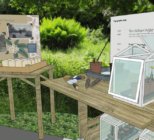Now imagine going out on your holidays, car packed up to the brim. You know you want to get to Devon or Dorset for your holidays, but you haven’t booked a campsite or cottage. You drive on to the motorway and take whichever exit or route you feel like, winding around, going here and there. Four days later, with screaming children and an irritable partner, you’ve ended up in a service station hotel outside of Coventry. Now, we wouldn’t dream of embarking on a holiday without planning a route or a destination, so why do we run our heritage sites like this?
The best way of ensuring your organisation is moving in the right direction is to develop a ‘vision’ and ‘masterplan’. A vision statement is a long-term aspirational goal, the destination or change you want your organisation to reach. A masterplan is the long-term journey or process you will undertake to reach that destination, normally covering aspects such as significant spatial interventions, major organisational developments such as the launch of cultural products, or new programmes.
Vision
Maybe you’ve got a vision, on paper, but does it reflect where the organisation is right now and the changing circumstances in which we are all living? Or perhaps your vision is too restrictive and isn’t allowing you to take innovative risks or support untested, yet creative, partnerships.
Everyone working in the sector knows this is not rocket science and many of you are already making considerable sacrifices to keep your museum open. So spending valuable time and money creating a masterplan doesn’t always seem like the best decision.
Yet, as we support different organisations on their journey, those without a clear direction are finding it harder to apply for funding or develop partnerships.
We’ve put together 10 Top Tips to help you develop a successful vision and masterplan for your heritage organisation. We can’t write your vision and masterplan for you (well we can, but you’ll have to pay us!) because it’s as individual to your organisation as your own personal journey. But we can give you some advice on choosing a destination, reading a map, creating a pathway and deciding how to get there.
Visioning:
Creating a vision is designing a long-term aspiration that shapes everything you do. It should be high-level and inspirational, not restrictive or time-specific.
Here are a few examples to get you thinking:
Ikea: “Our vision is to create a better everyday life for many people.”
National Museums Liverpool: “To be the world’s leading example of an inclusive museum service.
English Heritage: “Our work is informed by enduring values of authenticity, quality, imagination, responsibility and fun. Our vision is that people will experience the story of England where it really happened.”
1.Use founding principles to shape the long-term vision
The best place to start when establishing a vision is to look at your organisation’s founding principles. Why did someone create your museum? Why did your organisation come into being in the first place? These motivations are often still as applicable today as they were 200 years ago. If they’re not, can you take an element and make it appropriate for today? If the purpose of the charity was to protect the rights of Victorian workers, your new vision might be ‘to advocate for the rights of all workers in the UK.’
2. Be relevant
What all the examples above have in common is that they are relevant to contemporary life. They are not inward focused, but outward. They all have changing the lives of the broader public at their core. For heritage organisations, this is even more important. We believe that museums and heritage attractions change lives, so why not aspire to change some lives!
If you’re not sure what relevance is, we’ve written another article for Museums and Heritage Advisor: you can read it here for more inspiration.
3. Be Clear
As much as a vision needs to be relevant, it also needs to have purpose and direction. It needs to be clear. A vision should be so persuasive and straightforward that everyone, from the CEO to the volunteer, can explain it to you.
You won’t achieve a clear statement the first time. You might need to spend five or six sessions debating, comparing and distilling the things you want to include into one sentence. The benefit of this iterative process is that it begins to seep into your everyday thinking.
4. Be innovative
Don’t be tempted to copy someone else’s vision statement, or to ‘recycle’ one of your old ideas just because time is short. Be imaginative, innovative, and think about the issues facing your communities and the audiences you serve.
5. Be collaborative
Of all the suggestions, we’ve saved the best until last. Creating a vision cannot be something that is done by just the trustees or the CEO. It must be a collaborative process. Your volunteers, staff, board and wider community should all be involved in the process. Be representative of your target audience. Let them help guide you in making your vision relevant to them.
You could do this by having a cross-section vision committee, a small team from all areas in the organisation who are willing to work together to design a vision. Or, you could do a survey or volunteers and staff about what the organisation means to them. Perhaps you develop the vision and mission at senior level but ask staff and volunteers to feedback on them.
Whichever approach works well for you, be collaborative, and give the broader team a reason to feel involved and like they ‘own’ the vision.
Masterplanning:
Where visioning is establishing your direction, destination, and approach to making decisions, masterplanning is the ‘roadmap’ you use to get there.
6.Do your research
A masterplan, or strategic plan, will fall apart if it has not been researched. Make sure you are in discussion with your local authority about strategic plans for the region. Will there be building work near your museum in the next ten years? That will have an impact on your operations and visitor numbers, and could be a fantastic opportunity to reach new audiences.
What about education providers? Are local colleges and universities in your area beginning a heritage studies module? Could you partner with them to offer training or work placements?
There will always be issues that come along, but doing your research will help not only anticipate some of these problems but may also mitigate their impact if you have already put procedures in place.
7.Think about resources
Consider the resources you will need to get you to your desired position and evaluate whether your current model is the best approach.
Restructuring is never a pleasant experience, and should only be undertaken in the most significant of circumstances. Having a long-term vision, and how you plan to get there, should help design a staffing structure that is resilient.
Resources can also be your collection or property. How will you use these crucial assets during your masterplan? Will that have an impact on their care and condition? These considerations must be anticipated early on in the process, to avoid sudden surprises.
8.Break it down – Phasing
The easiest way to create a robust masterplan is to break it down into sections, or phases. Think about your long-term goal and break it up into defined ‘segments’ or ‘projects’. Not only will this help your peace of mind, but it will also help you apply for funding. Both public and private funders find it easier to get behind and financially support a ‘project’, rather than a general direction.
Make sure you also leave some flexibility in your masterplan to engage in smaller, spontaneous, creative partnership work. These smaller creative projects can form some of the most successful partnerships.
9.Future-proof your Board
Boards should be knowledgeable, supportive, and willing to invest time and effort into the organisation. They should be diverse in demographic and experience, but all passionate about your heritage. Check the skills and experience gaps in your Boards, don’t be afraid of asking younger individuals to be involved.
Above all, think about where your organisation needs to be in 10 years. Are the people around the table right now the people that should be there at the end?
10.Don’t rush
Rushing a masterplan can be tempting. Don’t. It pays to take your time and dedicate a significant chunk of time to its development and implementation.
If you don’t have the time, consider asking a consultant to write it for you. Consultants like Tricolor are able to write a masterplan on your behalf. Yet, we will still need your time and investment to create a document that is meaningful for your organisation. Good consultants will involve you in writing a masterplan. We do this through workshops and internal consultations. Be wary of those that will provide something ‘off the shelf’.
We want to help more organisations achieve long-term sustainability through a vision and masterplan. To help, we are offering a free planning session. Just quote the code MHVISION, when enquiring through our website.
To find out more about Tricolor and the work we do, follow us on Twitter @TricolorHeritag and Facebook – @TricolorAssociates.











